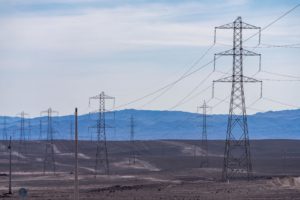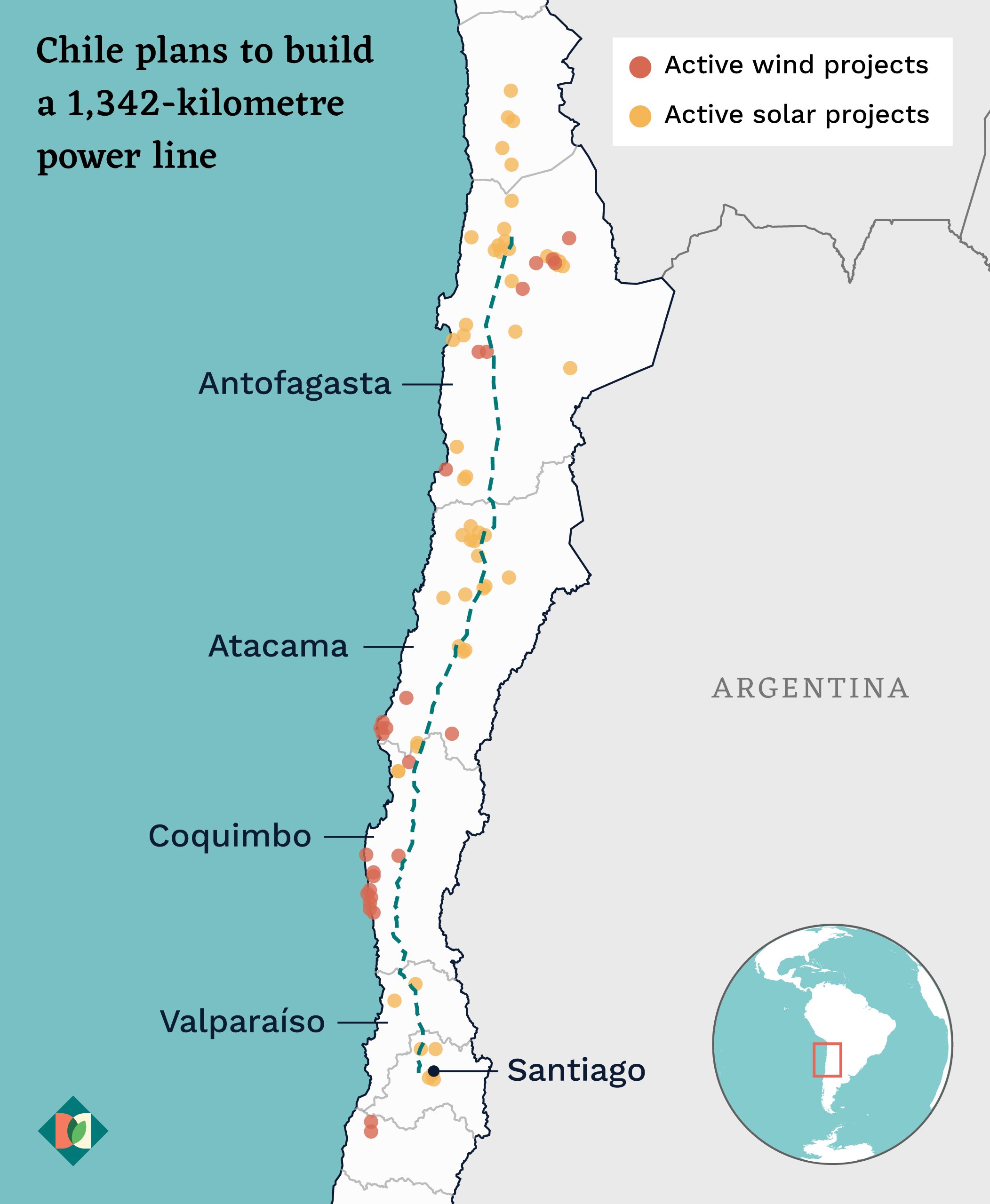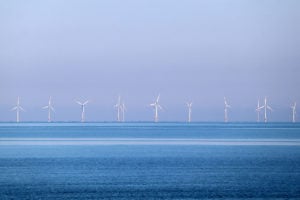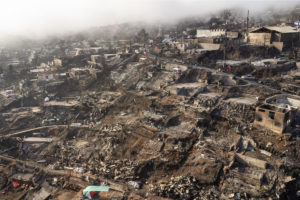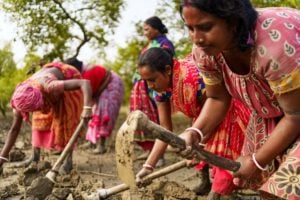Chile is set to build its longest power transmission line, as it looks to support its transition to clean energy. Stretching over 1,342 kilometres between the northern province of Antofagasta and the capital city Santiago, the Kimal-Lo Aguirre project will have capacity to carry 3,000 megawatts of power, and should help to fill a gap in infrastructure that currently sees large quantities of renewable energy never make it onto the grid.
According to Chile’s National Energy Policy of 2021, energy generation is responsible for 77% of the country’s greenhouse gas emissions. Transitioning to a cleaner energy system to lower these emissions is therefore a huge national challenge, but one Chile has made strides towards in recent years: its installed solar and wind energy capacity generated 37% of the energy in the system last year, the same percentage contributed by thermal energy.
However, according to a 2023 report by technology consultancy Fraunhofer Chile, the country’s rapid renewable energy capacity growth has also created a number of challenges, with its underdeveloped transmission infrastructure having been unable to keep up with the pace of change. This has resulted in what is known as curtailment.
The concept of curtailment evolved from terminology used for dams, explains Jorge Leal, an expert in renewable energies: “When dams have excess water, they have to spill some. So, when there is excess supply, power plants are also forced to get rid of energy – to curtail – and they start with those with variable production costs that are equal to zero, such as solar and wind power plants located in northern Chile.”
Leal says this energy curtailment arises because there is an oversupply of energy during sunlight hours, especially in the north and centre of the country, where many solar plants are located. This is because of the availability of land and the high levels of radiation, Leal adds. Furthermore, the demand for energy in the north of Chile “is not so great”, as its urban centres such as Arica and Iqique are not very large and have no significant industrial sectors.
It is therefore necessary for Chile’s long-term energy needs to expand its power transmission infrastructure. Sources from the country’s energy ministry said that the Kimal-Lo Aguirre project “will allow us to reach 2030 [greenhouse gas emission targets] by decoupling ourselves from this commitment to thermal energy in order to accelerate our investment in clean energy”.
However, the huge transmission line is still at the planning stage, awaiting confirmation on the locations of the pylons that will dot its route, and for the permission to build them. As the consortium behind the project seeks to finalise these details and its environmental impact assessment, it is also encountering objections from residents along the Kimal-Lo Aguirre line’s planned route.
The project
Following a call for tenders in 2020 from the National Electricity Coordinator (CEN), Chile’s grid operator, the Kimal-Lo Aguirre project was awarded to China Southern Power Grid (CSG) in 2021, in collaboration with the domestic companies Transelec and ISA Inversiones Chile.
State-owned CSG is one of China’s two major state-owned power distributors, and bought 27.7% of Transelec, Chile’s leading power transmission company, in 2018. The resulting consortium that will oversee Kimal-Lo Aguirre was named Conexión Energía. Works are yet to begin, but a goal of completing the project by 2029 has been set.
Diálogo Chino spoke to Conexión Energía’s general manager, Sebastián Fernández. He points out that Kimal-Lo Aguirre will be the first high-voltage direct current (HVDC) project built in the country. This type of technology, he says, is widely used in other countries that share Chile’s characteristics of “a large geographical extension and with focal points for renewable energy generation sources”. He highlights that Brazil, the United States, Canada, Norway, Sweden and China have had such long-distance lines for many years.
Power stations must be able to transmit electricity across long distances to reach electrical substations for distribution, which requires very high voltages. This high-voltage transmission can be achieved using either an alternating current (HVAC) or a direct current (HVDC).
In comparison with HVAC, HVDC can carry more power across longer distances while shedding less energy along the way. Furthermore, HVDC can transmit a higher voltage than HVAC through a cable of the same thickness, all while using smaller, cheaper power towers. These efficiency and financial considerations make HVDC preferable for transmission lines like the 1,342-kilometre Kimal-Lo Aguirre.
Among the advantages of HVDC technology, Fernández highlights the reduced need for circuits and cables. It also eliminates intermediate substations, “which generates a lower impact on the land and a considerably lower cost”.
HVDC is also very efficient in transporting energy over long distances, with lower energy losses than alternating current (AC) lines. “In a direct current [HVDC] line with the characteristics of Kimal-Lo Aguirre, the losses are approximately 150 MW,” says Fernández. “If this project had been with alternating current technology, these losses would have reached approximately 250 MW.”
Along its route through Chile, Kimal-Lo Aguirre will cross five regions and 28 communes (Chile’s smallest administrative areas, akin to municipalities), from Antofagasta’s María Elena commune to the Santiago Metropolitan Region commune of Pudahuel.
While the consortium is experienced in developing these types of transmission lines, this project represents a major challenge for the sector’s institutions and regulations. Diálogo Chino spoke to Carlos Finat, former executive director of the Chilean Renewable Energy and Storage Association (ACERA): “It will have to face the usual difficulties for this type of project, in terms of obtaining permissions [from landowners for the installation of pylons] and the questioning from communities at different points along the route.”
The usual, preliminary study to define the strips of land on which a project like this will be built was not carried out by the Chilean state. In theory, this decision intended to accelerate Kimal-Lo Aguirre’s completion by 2029. However, in Finat’s opinion that objective “will not be met”, because obtaining the necessary land permissions to build will be complicated – as he says is the case with most transmission system installation projects.
Finat stresses that the state having not carried out the study of these land strips simply means Conexión Energía will have to do it, “which leads to further questions over the project”. He adds that the consortium will also “have to do it under pressure while the deadlines, including the commissioning, are already approaching”.
Community challenges
The Kimal-Lo Aguirre project has already received feedback from citizens calling for changes to its route, which may test relations between the consortium and communities.
It’s not that the lines will pass close to our houses, but that the towers will be right next to themHéctor Carreño, lawyer and spokesperson for the El Molle neighbourhood council
El Molle, located in the Coquimbo region of northern Chile, is one such community. At least seven of Kimal-Lo Aguirre’s towers will pass through this village. “We are aware that it is an important project that is being executed in a very professional manner and that promotes the decarbonisation of Chile’s energy matrix,” says Héctor Carreño, a lawyer and spokesperson for El Molle’s neighbourhood council. “But we don’t want to have an 80-metre-high voltage tower next to our home.” Carreño is keen to emphasis this point: “It’s not that the lines will pass close to our houses, but that the towers will be right next to them.”
Faced with this, El Molle community members presented Conexión Energía with a proposal in April 2023 to move the project’s route nine kilometres east to an uninhabited area. “At first, we received a resounding ‘no’, but we are in ongoing discussions,” says Carreño.
Conexión Energía’s Fernández says that the route proposed in Kimal-Lo Aguirre’s current environmental impact assessment, drafted in October 2023, “has involved travelling the 1,342km route several times to create the necessary instances to listen to all the communities.” This assessment is currently at the public consultation stage, although it only covers the project’s construction, not its operation.
Fernández acknowledges that Conexión Energía has so far concentrated on the Kimal-Lo Aguirre project’s impacts on archaeological and paleontological cultural heritage, plants, soils, and the temporary disruption of three communities of Indigenous Diaguita people. He says the consortium anticipates further issues “that are currently being reviewed by the environmental authority”.
Chile’s National Forest Corporation (Conaf), the body in charge of administering forestry policy, raised its own concerns over the project in December: “In the opinion of this corporation, [the EIA] does not adequately address the impacts around flora and vegetation, resulting in a prediction that minimises or undervalues potential impacts. That is why we conclude that the EIA lacks essential information for the evaluation of the project.”
Conexión Energía estimates that Kimal-Lo Aguirre will start construction in 2025 and be operational in 2029, at a cost of US$2 billion. They have already managed to secure green credits (financing for environmental projects) worth US$480 million, in an arrangement with HSBC bank. In the meantime, local communities are waiting for their concerns to be incorporated into this project’s finalised plan. The Chilean government is currently reviewing the EIA and should formally make a decision on the project before the end of the year.
